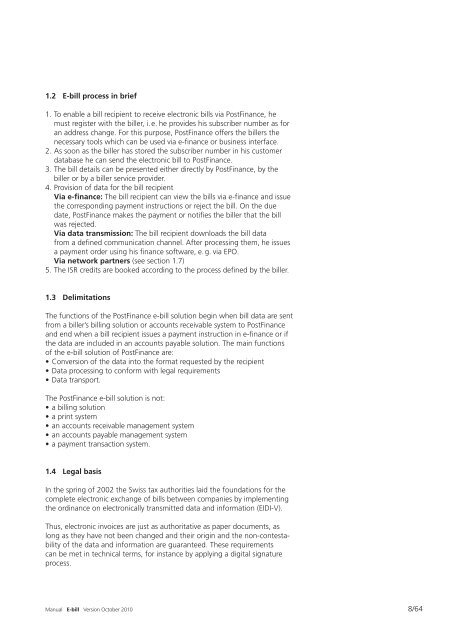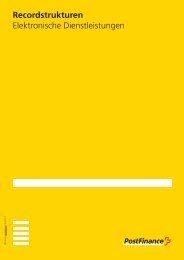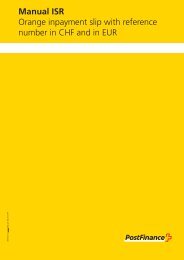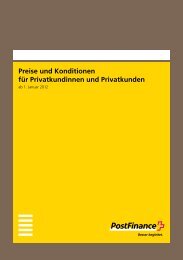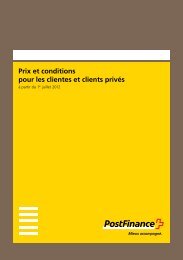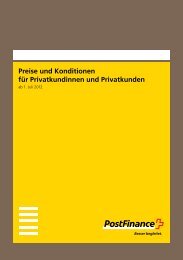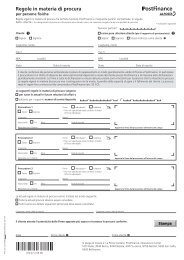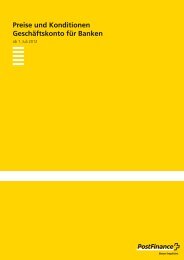Manual E-bill 499.41
Manual E-bill 499.41
Manual E-bill 499.41
You also want an ePaper? Increase the reach of your titles
YUMPU automatically turns print PDFs into web optimized ePapers that Google loves.
1.2 E-<strong>bill</strong> process in brief<br />
1. To enable a <strong>bill</strong> recipient to receive electronic <strong>bill</strong>s via PostFinance, he<br />
must register with the <strong>bill</strong>er, i. e. he provides his subscriber number as for<br />
an address change. For this purpose, PostFinance offers the <strong>bill</strong>ers the<br />
necessary tools which can be used via e-finance or business interface.<br />
2. As soon as the <strong>bill</strong>er has stored the subscriber number in his customer<br />
database he can send the electronic <strong>bill</strong> to PostFinance.<br />
3. The <strong>bill</strong> details can be presented either directly by PostFinance, by the<br />
<strong>bill</strong>er or by a <strong>bill</strong>er service provider.<br />
4. Provision of data for the <strong>bill</strong> recipient<br />
Via e-finance: The <strong>bill</strong> recipient can view the <strong>bill</strong>s via e-finance and issue<br />
the corresponding payment instructions or reject the <strong>bill</strong>. On the due<br />
date, PostFinance makes the payment or notifies the <strong>bill</strong>er that the <strong>bill</strong><br />
was rejected.<br />
Via data transmission: The <strong>bill</strong> recipient downloads the <strong>bill</strong> data<br />
from a defined communication channel. After processing them, he issues<br />
a payment order using his finance software, e. g. via EPO.<br />
Via network partners (see section 1.7)<br />
5. The ISR credits are booked according to the process defined by the <strong>bill</strong>er.<br />
1.3 Delimitations<br />
The functions of the PostFinance e-<strong>bill</strong> solution begin when <strong>bill</strong> data are sent<br />
from a <strong>bill</strong>er’s <strong>bill</strong>ing solution or accounts receivable system to PostFinance<br />
and end when a <strong>bill</strong> recipient issues a payment instruction in e-finance or if<br />
the data are included in an accounts payable solution. The main functions<br />
of the e-<strong>bill</strong> solution of PostFinance are:<br />
• Conversion of the data into the format requested by the recipient<br />
• Data processing to conform with legal requirements<br />
• Data transport.<br />
The PostFinance e-<strong>bill</strong> solution is not:<br />
• a <strong>bill</strong>ing solution<br />
• a print system<br />
• an accounts receivable management system<br />
• an accounts payable management system<br />
• a payment transaction system.<br />
1.4 Legal basis<br />
In the spring of 2002 the Swiss tax authorities laid the foundations for the<br />
complete electronic exchange of <strong>bill</strong>s between companies by implementing<br />
the ordinance on electronically transmitted data and information (EIDI-V).<br />
Thus, electronic invoices are just as authoritative as paper documents, as<br />
long as they have not been changed and their origin and the non-contestability<br />
of the data and information are guaranteed. These requirements<br />
can be met in technical terms, for instance by applying a digital signature<br />
process.<br />
<strong>Manual</strong> E-<strong>bill</strong> Version October 2010 8/64


